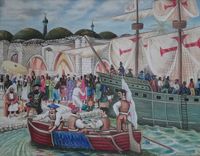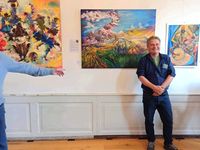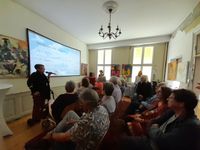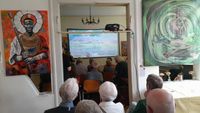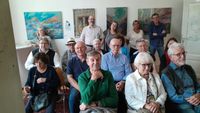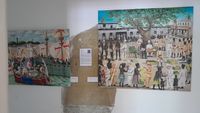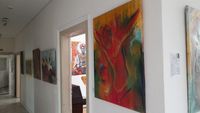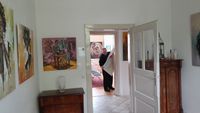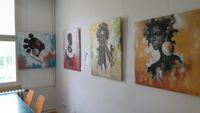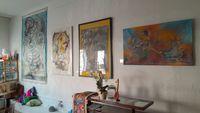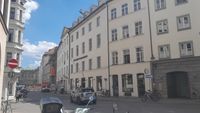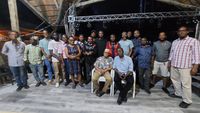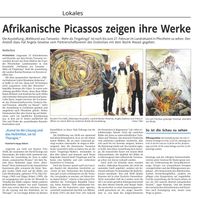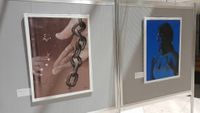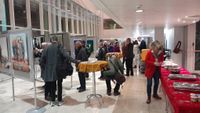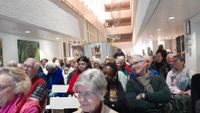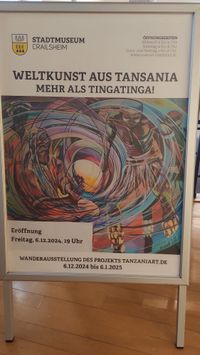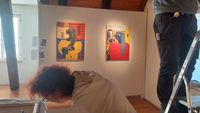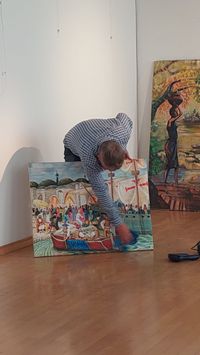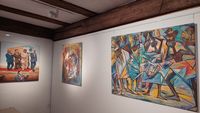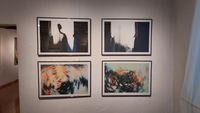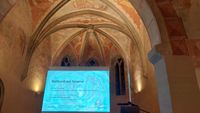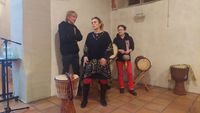(9.6.2025)
Wunderbare Vernissage im KulturTrif(f)t
Celle ist der erste und auch in Zukunft wahrscheinlich einzige Ausstellungsort, an dem es keine organisierten Tansania-Freunde gibt, also keine Kirchengemeinde, keine Schule, kein Freundeskreis, die eine Partnerschaft zu ähnlichen Institutionen in Tansania pflegen. Trotzdem war die Vernissage mit rund 60 Gästen gut besucht, kein Stuhl blieb freu. Sie kamen, sahen und erfreuten sich an 50 Werken, die in drei Räumen und den langen Fluren des soziokulturellen Zentrums KulturTrif(f)t Platz finden. Weitere sieben Werke hängen in der Zweig- und Infostelle des Zentrums am Großen Plan, einem der drei Markplätze der mittelalterlichen Stadt.
Dem halbstündigen Einführungsvortrag von Projektorganisator Fritz Gleiß, der sich eindrücklich gegen die gängige Perzeption tansanischer Kunst als "naiv" stellte, folgten eine Menge Gespräche bei einigen Gläsern Sekt. Drei Bilder fanden bereits an diesem Abend begeisterte Käufer, weitere Verkäufe sollen folgen.
Wonderful vernissage at the KulturTriff(f)t
Celle is the first, and likely the only, exhibition venue without organized Tanzania Friends—that is, no church congregation, no school, no circle of friends that maintains partnerships with similar institutions in Tanzania. Nevertheless, the opening was well attended, with around 60 guests; not a single seat remained empty. They came, saw, and enjoyed 50 works displayed in three rooms and the long corridors of the socio-cultural center KulturTriff(f)t. A further seven works hang in the center's branch and information center on Grosser Plan, one of the medieval city's three marketplaces.
The half-hour introductory lecture by project organizer Fritz Gleiß, who impressively challenged the common perception of Tanzanian art as "naive," was followed by lively discussions over several glasses of champagne. Three paintings already found enthusiastic buyers that evening, and more sales are expected to follow.
(5.6.2025)
Vorab-Präsentation ausgewählter Bilder
Um auf die Ausstellung aufmerksam zu machen, hängen schon zuvor einige ausgewählte Werke im zentral gelegenen Infopoint des Kulturzentrums KulturTrif(f)t am Großen Plan - Bilder, die in den Räumen in der Trift 32 keinen Platz mehr gefunden hätten.
Advance presentation of selected works
To draw attention to the upcoming exhibition in Celle, a selection of works will be displayed in advance at the centrally located information point of the KulturTriff(f)t cultural center on Großer Plan – works that would have no space in the rooms at Trift 32.
(31.5./1.6. 2025)
Schöner Vorabbericht auf Celle Heute, reinklicken!
Nice preview on Celle Heute (German only), click here!
(Juni 2025)
Matinee mit "feministischer Midissage"
Den Blick auf eine Ausstellung, in der nur ein Fünftel der Künstler:innen Frauen sind, aus weiblicher Perspektive werfen: Das kann den beiden Kuratoren David Kyungu und Fritz Gleiß kaum gelingen. Dafür haben wir jetzt erstmals Mittel eingeworben und freuen uns, Diana Kajuna aus dem Deutsch-Tansanischen Freundeskreis (DTF) als Referentin gewonnen zu haben. Die Deutsch-Tansanierin Kajuna (42) lebt seit gut 20 Jahren in Deutschland. Sie arbeitet als Sozialpädagogin in München. Mit besonderem Interesse schaut sie auf Gender- und Bildungsfragen und wird nicht nur Werke und Positionen der Ausstellung feministisch einordnen, sondern uns sicher auch einiges über die spezifischen Bedingungen erzählen, unter denen sich Frauen in den Kunst- und Kulturbetrieb in Tansania einbringen.
So laden wir am Sonntag, dem 29.6., um 11 Uhr zu einer Matinee, die wir "feministische Midissage" getauft haben. Die Veranstaltung, die von der KulturTrif(f)t-Vorsitzenden Sabine Schöllchen moderiert wird, ist offen für Menschen jederlei Geschlechts, der Eintritt ist frei.
Matinee with "feminist midissage"
Looking at an exhibition in which only one-fifth of the artists are women from a female perspective: this is something that the two curators, David Kyungu and Fritz Gleiss, can hardly achieve. We have now raised funding for this for the first time and are delighted to had won Diana Kajuna from the German-Tanzanian Friends Association (DTF) as a speaker. Kajuna (42), a German-Tanzanian, has lived in Germany for over 20 years. She works as a social worker in Munich. She focuses particularly on gender and educational issues and will not only provide a feminist context for the works and positions in the exhibition, but will also certainly tell us something about the specific conditions under which women participate in the art and cultural scene in Tanzania.
On Sunday, June 29, at 11 a.m., we invite you to a matinee we've dubbed "Feminist Midissage." The event, moderated by KulturTriff(f)t chairwoman Sabine Schöllchen, is open to people of all genders, and admission is free.
(Mai/Juni 2025)
Kino bringt sich ein
Auch das ein Novum: Unsere Initiative, die Zeit der Ausstellung für weitere Aktionen zu nutzen, nahm Gül Gezer vom Celler Filmpalast umgehend positiv auf. So zeigen die Kammerlichtspiele am Donnerstag, dem 19. Juni, um 17.30 Uhr das tansanisch-deutsche Dokudrama "Das leere Grab", das letztes Jahr auf der Berlinale für Furore sorgte. Schon zuvor lässt sich der Film auf der Website des Kinos erwerben, kostenlos einsehen kann man ihn den Sommer über auch in der ZDF-Mediathek.
Den Folgen der deutschen Kolonialherrschaft am Schicksal zweier tansanischer Familien nach über 100 Jahren nachzuspüren gelingt in der Ungestörtheit eines Kinosaals vor dessen großer Leinwand gewiss am besten! Hereinspaziert! Am besten gemeinsam mit der ganzen Klasse oder befreundeten, nahen Menschen.
Cinema gets involved
This also is a first: Our initiative to use the exhibition period for further activities was immediately welcomed by Gül Gezer from the Celle cinema. On Thursday, June 19, at 5:30 p.m., the Kammerlichtspiele will be showing the Tanzanian-German docudrama "The Empty Grave" (languages Swahili/English/German) which caused a little sensation at last year's Berlinale. The film can be purchased in advance on the cinema's website, and it will also be available to view for free in the ZDF media library throughout the summer. Tracing the consequences of German colonial rule on the fate of two Tanzanian families more than 100 years later however is certainly best achieved in the privacy of a cinema in front of its large screen! Come on in! Ideally, together with friends and loved ones.
(Mai/Juni 2025)
3. Ausgabe gefördert mit Mitteln des BMZ
Da sind wir nun doch ein bisschen stolz drauf: Der Antrag auf Projektförderung für die Celler Ausstellung durch Engagement Global, die Mittel aus dem BMZ an entwicklungspolitische Initiativen vergeben, wurde bewilligt. Insgesamt stehen so nun für die dritte Ausgabe der "Weltkunst aus Tansania - mehr als Tingatinga"-Wanderausstellung gut 2.500 € zur Verfügung, um unsere Anliegen - die Dekolonsierung der Perzeption tansanischer Kunst in Deutschland - durch die Bilder, Künstlerbiografien, Vernissage mit Einführungsvortrag, eine feministische Midissage, einen Workshop mit dem tansanischen Künstler Nimrod Hanai und eine landeskundlich ausgelegte Finissage unters Volk zu bringen. Das Geld unterstützt auch die Arbeit des Ausstellers, des soziokulturellen Zentrums KulturTrif(f)t. Denn so ist die Wanderausstellung ja konzipiert: Sie findet stets statt in Kooperation mit einem lokalen Veranstalter, der dadurch auf sich und seine Arbeit aufmerksam macht und ggf. auch öffentliche und Sponsoren-Mittel für sich einwirbt. Wer möchte, dass die Ausstellung auch in der eigenen Region Station macht, kontaktiere uns.
3rd edition co-financed by the Federal Government
We're quite proud of this: The application for project funding for the Celle exhibition from Engagement Global, which awards funds from the Federal Ministry for Economic Cooperation and Development (BMZ) to development initiatives, has been approved. A total of just over €2,500 is now available for the third edition of the "World Art from Tanzania - More than Tingatinga" traveling exhibition. We will be able to bring our concerns – decolonizing the perception of Tanzanian art in Germany – to the public through the images, artist biographies, a vernissage with an introductory lecture, a feminist mid-opening, a workshop with Tanzanian artist Nimrod Hanai, and a closing event focusing on the region. The money also supports the work of the exhibitor, the socio-cultural center KulturTriff(f)t. This is precisely how the traveling exhibition is designed: It always takes place in cooperation with a local organizer, who thereby draws attention to their work and, if necessary, also raises public and sponsorship funds for themselves. If you like to see the show in your region too, don't hesitate to contact us.
(Mai 2025)
Ausstellung in Celle mit vielen neuen Bildern
Am Freitag, dem 6.6., wird die dritte Ausgabe der "Weltkunst aus Tansania - mehr als Tingatinga!"-Show mit einer Vernissage ab 18 h im Kulturzentrum Kulturtrif(f)t, Trift 32, in Celle eröffnet. Danach ist die Ausstellung, die rund 50 Werke von 25 zeitgenössischen Künstler:innen zeigt, bis zum 6.7. zusehen. Zur Halbzeit wird eine "feministische Midissage" Ausstellung und Arbeitsbedingungen aus weiblicher Perspektive einordnen. Am 5.7. lädt dann der tansanische Künstler Nimrod Hanai ein zu einem Workshop für Jugendliche und Erwachsene, bevor die Show am Sonntag, dem 6.7., ab 11 h mit einer Finissage beendet wird. Parallel planen die Kammerspiele, das preisgekrönte Dokudrama "Das leere Grab" (2024) zu zeigen. Der Termin dafür steht in Kürze fest.
Dank der vielen Verkäufe während der ersten beiden Aussstellungen in Crailsheim und Pforzheim sind in Celle viele neue Werke zu bestaunen. Vier Maler - MacSawaya, Fadhil Raisy, Omari Chenga und Henry Kirenga - sind erstmals dabei. Die vollständige Liste der in Celle beteiligten Künstler:innen finden Sie hier. Der Einführungsvortrag des Organisators Fritz Gleiß bei der Vernissage beginnt um 19 Uhr und ist frei zugänglich.
Exhibition in Celle with many new works
On Friday, June 6, the third edition of the "World Art from Tanzania - More than Tingatinga!" exhibition will open with a vernissage starting at 6 p.m. at the Kulturtriff(f)t cultural center, Trift 32, in Celle. The exhibition shows more than 50 works of 25 contemporary artists. It will be on view until July 6. At the halfway point, a "feminist midissage" will examine the exhibition and working conditions from a female perspective. On July 5, Tanzanian artist Nimrod Hanai will host a workshop for young people and adults, before the show concludes with a finissage on Sunday, July 6, starting at 11 a.m.
Thanks to the strong sales during the first two exhibitions in Crailsheim and Pforzheim, many new works can be admired in Celle. Four painters—MacSawaya, Fadhil Raisy, Omari Chenga, and Henry Kirenga—are participating for the first time. The complete list of artists participating in Celle can be found here. The introductory lecture by organizer Fritz Gleiß at the vernissage begins at 7 p.m. and is open to the public.
(Mai 2025)
Münchner Ausstellung in trockenen Tüchern
Ein Besuch des Projekt-Organisators Fritz Gleiß in München räumte letzte Zweifel aus. Die dortige Urbis-Foundation, die die Filiale der privaten St. Galler Kantonal Bank Deutschland AG als Unterstützerin und Raumgeberin gewinnen konnte, hatte den Vorabbesuch ermöglicht, um die Raumbedürfnisse abzuklären. Normalerweise zeigen wir rund 45 Werke von 25 Künstler:innen. Bei dieser ersten Ausstellung in München wird leider nur Platz für knapp 30 Bilder von 20 Maler:innen sein. Da sich jedoch viele weitere Münchener Initiativen wie z.B. der Deutsch-Tanzanische Freundeskreis (DTF) für die Ausstellung interessieren, hoffen wir in 2026 die vollständige Sammlung noch einmal in der Nähe präsentieren zu können. Die Ausstellung in der Kantonal Bank (Prannerstr. 11, 2. Stock, Fahrstuhl vorhanden) wird vom 10.10. bis zum 23.12. zu den normalen Öffnungszeiten (Mo-Fr 9-17.30 h) öffentlich zugänglich sein, Gruppen melden sich bitte vorher an (089 12501830). Zur Vernissage am 9.10. sind aus Platzgründen nur geladene Gäste zugelassen.
Munich exhibition finalized
A visit to Munich by project organizer Fritz Gleiß dispelled any remaining doubts. The Urbis Foundation, which was able to secure the support of the branch of the private Swiss St. Gallen Kantonal Bank to provide the space, had arranged the preliminary visit to clarify the space requirements. We normally show around 45 works by 25 artists. Unfortunately, this first exhibition in Munich will only have room for around 30 paintings by 20 artists. However, since many other Munich initiatives, such as the DTF, have shown interest in the exhibition, we hope to be able to present the complete collection nearby in 2026. The exhibition at the Kantonal Bank (Prannerstr. 11, 2nd floor) will be open from October 10 to December 23 during normal opening hours (Mon-Fri 9 a.m.-5:30 p.m.). Groups are asked to register in advance (089 12501830). Due to space constraints, the opening on October 9 is open only for invited guests. Tanzanian artists who happen to be in Germany at this time and like to be with us should contact the organizer.
(April 2025)
Neue Termine für 2026, Absagen für 2025
Das Ausstellungs-Organisieren kennt Auf-und-Abs. So haben wir derzeit fürs kommende Jahr vier neue Ausstellungen im Programm (s. Trailer oben), gleichzeitig wurden sowohl die in Ahlen (Freundeskreis Bagamyoyo!) als auch die geplante Ausstellung in der Berliner Kirche zum Guten Hirten aus Geldgründen gecancelt. In Berlin schien es offenbar einigen kirchlich Engagierten nicht geheuer, dass die Bilder der Ausstellung selbstverständlich zum Verkauf stehen und so die beteiligten Künstler:innen wie auch die gesamte Kulturszene direkt unterstützen. Schade!
New dates for 2026, cancellations for 2025
Organizing an exhibition has its ups and downs. We currently have four new exhibitions planned for next year (see trailer above), but at the same time, both the exhibition planned in Ahlen (Freundeskreis Bagamyoyo!) and the one at the Kirche zum Guten Hirten in Berlin were canceled due to financial constraints. In Berlin, some church-affiliated people apparently felt uncomfortable with the fact that the paintings in our exhibition were, of course, for sale, thus directly supporting the participating artists. What a shame!
(April 2025)
Spannende Begegnungen, dramatische Abläufe
Zum Transport der Ausstellungswerke fliegt einer der beiden Orgsanisatoren, Davod Kyungu oder Fritz Gleiß, derzeit desöfteren zwischen Dar und Deutschland hin und her. Die letzte Reise startete Ende März mit einem zweiten großen Künstlertreffen im Brake Point Makumbusho in Dar, an dem erneut rund 20 Interessierte teilnahmen, darunter fünf, die bisher nicht beteiligt sind. An dem Abend erfuhren die Künstler:innen aus erster Hand, wie die beiden ersten Ausstellungen und die Verkäufe gelaufen sind und welche Pläne die Ausstellungsmacher hegen. So möchten wir es schaffen, zum Ende der Ausstellungszeit hin in mindestens einem der großen ex-Völkerkundemuseen in Deutschland auszustellen. Steht doch unser gesamter Ansatz unter dem Motto "Decolonize Perceptions", was diese Häuser eigentlich anziehen müsste wie das Licht.
v.l./from left: Mac Sawaya, Halifa Hamis, Henry Wilhelm Kirenga, Jamal Ali Mohammed, Aggrey Mwasha, Happy Robert, Fadil Raisy, Haji Chilonga,
James Haule, Lazaro Samuel, Ochu, Vita Malulu, Barnabas Mnemba, Lute Mwakisopile, Omari Chenga, Evarist Chikawe, Cuthbert Semgoja
sitzend/seeted: Raza Mohamed, David Kyungu; nicht im Bild/not portrayed: Muzu Suleimanji, Beatrice Mashala (Dar es Salaam, 29.3.25)
Fast allerdings wäre bereits gestern Schluss gewesen mit der tollen neuen Bilderschau, die sich nach 15 Wegverkäufen aus dern ersten beiden Ausstellungen durch viele neue Bilder und auch neue beteiligte Künstler aus Tansania derzeit entwickelt. Denn die dicht bepackten Bilderrollen, eingeschweißt und als Sondergepäck kostenfrei in Dar es Salaam aufgegeben, tauchten bei der Gepäckausgabe in Hannover nicht wieder auf. (Den Vertrauensverlust der Künstler:innen in das Projekt möchten wie uns gar nicht ausmalen, hätten wir ihnen den Verlust ihrer Werke erklären müssen.) Doch Turkish Airlines sei gedankt: Schon 12 Stunden später lagen sie in Celle vor der Tür des Orgnisators. (Auch das sonst noch fehlende Restgepäck ...) Jetzt dürfen Sie gespannt sein auf die neuen Werke und Künstler (ja, leider, keine neuen Künstlerinnen dabei)!
Exciting encounters, dramatic sequences
To transport the exhibition works, one of the two organizers, Davod Kyungu or Fritz Gleiß, is currently flying back and forth between Dar and Germany on a regular basis. The most recent trip began at the end of March with a second major artists' meeting at Brake Point Makumbusho in Dar, which was again attended by around 20 interested people, including five who had not previously participated. That evening, the artists learned firsthand how the first two exhibitions and sales went, as well as what the exhibition organizers' plans are. We hope to be able to exhibit in at least one of the major former ethnographic museums in Germany by the end of the exhibition period. After all, our entire approach is based on the motto "Decolonize Perceptions," which should actually attract these institutions like light.
However, the fantastic new exhibition almost came to an end yesterday. After 15 sales from the first two exhibitions, it is now evolving into a collection of many new works and new participating artists from Tanzania. The tightly packed rolls of their paintings, shrink-wrapped and checked in as special baggage free of charge in Dar es Salaam, never reappeared at the baggage claim in Hanover. (We can't even imagine the artists' loss of faith in the project if we had to explain the loss of their works to them.) But thanks to Turkish Airlines, they were lying on the organizer's doorstep in Celle just 12 hours later. (As was the remaining luggage...) Now you can look forward to the new works and artists (unfortunately, no new female artists among them)!
(Februar 2025)
Titelbild bleibt im Landratsamt!
Das hatten wir uns so nicht gedacht: Bastain Rosenau höchstselbst, seines Zeichens Landrat des Enzkreises um Pforzheim, hat den Ankauf von Suleiman Bindas Großbild "Msewe" veranlasst. Das Titelbild der Kataloge der ersten beiden Ausgaben der Show in Crailsheim und Pforzheim bleibt so auf unabsehbare Zeit den Enzkreisler:innen vorbehalten. Chapeau!
Cover photo remains in the district office!
We didn't think so: Bastain Rosenau, the district administrator himself arranged for the purchase of Suleiman Binda's large picture “Msewe”, the cover photo of the catalogs for the first two editions of the show in Crailsheim and Pforzheim. Now, for the foreseeable future, it will be up to Enzkreis residents to marvel at the magnificent work. Cheers!
Translation (abstract):
African Picassos show their works
The exhibition “World Art from Tanzania – More than Tingatinga” can be seen in the district office in Pforzheim until February 27th. Angela Gewiese from the Enzkreis partnership association with the Masasi district provided the impetus for this.
by Eva Filitz
PFORZHEIM. A total of 23 artists from distant Tanzania are currently transforming the foyer of the Pforzheim district office with their pictures into an Art Hall. “World art from Tanzania – More than Tingatinga” is the title of the exhibition, that District Administrator Bastian Rosenau recently has opened.
With the Tanzanian saying “Milima Haikutani Lakini Binadamu Hukutana” – “Hills and valleys don not come together, but people” – Rosenau welcomed the guests. That were very harmoniously chosen words, because these pictures build bridges from the Enzkreis to Africa and connect people on an artistic basis. Angela Gewiese, the chairwoman of the partnership association “Marafiki wa Masasi”, had seen the exhibition in Crailsheim and immediately brought it to Pforzheim. There was information material about the association and a handy art catalog on bar tables in which the curating project tanzaniart.de on 67 pages describes detailed vita and works of the exhibiting artists.
“Art is the solution and the cure, it is therapy." (Artist Happy Robert)
Curator an creator of the exhibition, Fritz Gleiß, came from Celle, his colleague David Kyungu from
Dar es Salaam unfortunately was not present. That the Tanzanian art scene has not only its own "Picasso” Raza Mohamed but even its “Rembrandt” Muzu Suleimanji, amazed the guests. The curator also aroused curiosity about the pictures of Lute Mwakisopile (born 1973), Haji Chilonga (1969) and Happy Robert (1989), the three who last year at the 60th Biennale in Venice showed their pictures. Among other African countries Tanzania was represented there for its first time ever. "Art is the solution and the cure, it is therapy", this quote by Happy Robert can be read in the exhibition catalog. Haji Chilonga was her teacher.
The introduction of Gleiß was exciting and varied because he always accompanied it with new pictures that were shown on a screen. He convincingly showed that the Tanzanian art scene today has much more to offer than the naive Tingatinga paintings, created in the 1960s and named after its founder Edward Saidi Tingatinga and up today a popular and widespread art form in Tanzania.
But Gleiß also addressed a sad chapter in German history: “Among all the crimes of colonialism, there was none worse than the attempts to make us believe that we had no culture of our own,” he quoted the first president of the United Republic of Tanzania, Julius Nyerere. A picture of Mikidadi Bush, "The arrival of the Germans in Bagamoyo", with many shocking details clearly conveys deep, comprehensive insights into how the colonists once operated.
But the rest images with their diverse techniques and themes, on the one hand, impressions about simple country life, but also escalating into the surreal, are cheering up the mood again. The district administrator said he hoped that this exhibition would help bring a new look to Tanzanian art to perceive. The quality of the pictures is so convincing that four of them already were sold during the opening.
(23.1.2025)
Schöne Presse in Pforzheim!
Two dailys reported on the opening. You can find the German versions by clicking above. Headlines from the Mühlacker Tagblatt translated:
Great art contradicts all racist clichés
Exhibition opened at district office with paintings from Tanzania. Top-class works show no trace of “naive decorative art”.
(22.1.2025)
Wunderbare Vernissage auch in Pforzheim
Auch die zweite Vernissage der Wanderausstellung "Weltkunst aus Tansania - Mehr als Tingatinga!" am heutigen Abend im Landratsamt des Enzkreises in Pforzheim stieß auf unerwartet großes Interesse. An die 80 Gäste genossen die launige Begrüßung durch den Landrat, Trommelklänge aus Guinea, unsere antirassistische Einführung, Wein und nachhaltige Häppchen und danach noch eine gute Stunde lang die Kunst und Gespräche. Bislang kam es schon zu vier Verkäufen.
Wonderful opening in Pforzheim too
The second vernissage of the traveling exhibition "World Art from Tanzania - More than Tingatinga!" yesterday evening in the district office of the Enzkreis in Pforzheim met with unexpectedly great interest. Around 80 guests enjoyed the cheerful welcome from the district administrator Bastian Rosenau, the sound of drums from Guinea, our anti-racist introduction, wine and sustainable snacks and then a good hour of art and conversation. There have already been four sales so far.
(Januar 2025)
„Mehr als Tingatinga“
Eröffnung der Ausstellung „Weltkunst aus Tansania“ im Landratsamt Enzkreis
Kraichgau News, 13.1.25 (ähnlich auch: Pforzheimer Zeitung, 10.1., Mühlacker Tagblatt, 11.1.)
„Mehr als Tingatinga“: Ab dem 21. Januar ist im Landratsamt eine Ausstellung unter dem Titel „Weltkunst aus Tansania“ zu sehen. Der Enzkreis unterhält seit Jahren eine rege Partnerschaft mit der Stadt und dem Distrikt Masasi im Süden des afrikanischen Landes.
Der Enzkreis hat eine besondere Beziehung zu Tansania: Seit 2011 unterhält er eine lebendige Partnerschaft mit Masasi Town und Masasi District im Süden des afrikanischen Landes. „Es kommt also nicht von ungefähr, dass wir alles daran gesetzt haben, eine Wanderausstellung mit tansanischer Kunst in die Region zu holen. Und das ist uns erfreulicherweise auch gelungen“, berichtet Angela Gewiese. Sie ist hauptberuflich in der Kreisverwaltung für den Klimaschutz tätig und im Ehrenamt langjährige Vorsitzende des Partnerschaftsvereins „Marafiki wa Masasi“.
Eröffnet wird die von Fritz Gleiß (Münster + Celle) und David Kyungu (Dar es Salaam) kuratierte Ausstellung unter dem Titel "Weltkunst aus Tansania" am Dienstag, 21. Januar, um 18 Uhr in der Eingangshalle des Landratsamtes Enzkreis in der Zähringerallee 3 in Pforzheim. Die Bevölkerung ist dazu herzlich eingeladen.
23 zeitgenössische Meister im Fokus
Gezeigt werden anspruchsvolle Werke von 23 zeitgenössischen Malerinnen und Malern. Vertreten sind unter anderem „Tansanias Picasso“ Raza Mohamed, der "Rembrandt" des Landes, Muzu Suleimanji, der Historienmaler Mikidadi Bush sowie mit Lute Mwakisopile, Haji Chilonga und Happy Robert alle drei Teilnehmenden an der 60. Biennale in Venedig, auf der Tansania erstmals mit einem eigenen Pavillon vertreten war.
Ausstellung zeigt die Vielfalt der Kunstszene Tansanias
Bei der Ausstellungseröffnung wird nach der Begrüßung durch Landrat Bastian Rosenau Kurator Fritz Gleiß in die Ausstellung einführen. Danach besteht die Möglichkeit, sich bei einem kleinen Imbiss die Bilder genauer anzuschauen. „Ich verrate nur so viel: Wir zeigen, dass die Kunstszene Tansanias wesentlich mehr zu bieten hat als die naive Tingatinga-Malerei“, so Gleiß. Er meint damit die in den 1960er Jahren in Tansania entstandene und nach ihrem Begründer Edward Saidi Tingatinga benannte, heutzutage weit verbreitete Kunstform.
Wer an der Eröffnung der Ausstellung, die in Kooperation mit dem „Webprojekt tanzaniart.de“ auf die Beine gestellt wurde, dabei sein möchte, sollte sich bis zum 16. Januar per Mail an angela.gewiese@enzkreis.de oder telefonisch unter 07231 3089486 anmelden. Danach kann die Ausstellung bis zum 27. Februar montags von 8 bis 12.30 Uhr, dienstags von 8 bis 12.30 und von 13.30 bis 18 Uhr, donnerstags von 8 bis 14 Uhr sowie freitags von 8 bis 12 Uhr besichtigt werden.
"More than Tingatinga"
Opening of the exhibition “World Art from Tanzania” in the Enzkreis district office
Kraichgau News, January 13th, 2025 (similar at Pforzheimer Zeitung, Jan. 10th; Mühlacker Tagblatt, Jan. 11th)
“More than Tingatinga”: From January 21st, an exhibition entitled “World Art from Tanzania” can be seen in the district office. The Enzkreis has had a lively partnership with the city and the district of Masasi in the south of the African country for years.
The Enzkreis has a special relationship with Tanzania: since 2011 it has maintained a lively partnership with Masasi Town and Masasi District in the south of the African country. “It is no coincidence that we have done everything we can to bring a traveling exhibition of Tanzanian art to the region. And fortunately we succeeded in doing that,” reports Angela Gewiese. She works full-time in the district administration for climate protection and is the long-time chairwoman of the “Marafiki wa Masasi” partnership association.
The exhibition curated by Fritz Gleiß (Münster + Celle) and David Kyungu (Dar es Salaam) under the title "World Art from Tanzania" will open on Tuesday, January 21st, at 6 p.m. in the entrance hall of the Enzkreis district office at Zähringerallee 3 in Pforzheim. The public is cordially invited to attend.
23 contemporary masters in focus
Challenging works by 23 contemporary painters will be shown. Represented include "Tanzania's Picasso" Raza Mohamed, the country's "Rembrandt", Muzu Suleimanji, the historical painter Mikidadi Bush as well as Lute Mwakisopile, Haji Chilonga and Happy Robert, all three participants in the 60th Venice Biennale, where Tanzania for the first time was represented with its own pavilion.
Exhibition shows the diversity of Tanzania's art scene
At the opening of the exhibition, after the welcome from District Administrator Bastian Rosenau, curator Fritz Gleiß will introduce the exhibition. Afterwards you have the opportunity to take a closer look at the pictures while enjoying a small snack. “I will only reveal this much: We show that the Tanzanian art scene has much more to offer than naive Tingatinga painting,” says Gleiß. By this he means the art form that was created in Tanzania in the 1960s and named after its founder Edward Saidi Tingatinga.
Anyone who would like to take part in the opening of the exhibition, which was put together in cooperation with the tanzaniart.de, should send an email to angela.gewiese@enzkreis.de or call 07231 3089486 by January 16th to register. The exhibition can then be viewed until February 27th on Mondays from 8 a.m. to 12:30 p.m., Tuesdays from 8 a.m. to 12:30 p.m. and from 1:30 p.m. to 6 p.m., Thursdays from 8 a.m. to 2 p.m. and Fridays from 8 a.m. to 12 p.m.
(Januar 2025)
Erfolgreicher Abschluss der ersten Show
Die Premiere in Crailsheim war vom ersten bis zum letzten Tag ein voller Erfolg. Mehr als 100 Gäste zur Eröffnung, insgesamt 458 Besucher:innen an 16 gut besuchten Ausstellungstagen und viele Verkäufe: Künstler:innen, Organisatoren und Kooperationspartner waren rundum zufrieden (vgl. unten). Jeder Dritte beteiligte Künstler:innen freute sich über Einnahmen, die ihm bzw. ihr neue Möglichkeiten der künstlerischen Entfaltung bieten. Die nächste Ausstellung 150 km südwestlich in Pforzheim, das eine Klimapartnerschaft mit der Region Mtwara verbindet, wurde direkt vor Ort "gebucht", zum Glück war das Zeitfenster noch offen. So freuen wir uns jetzt auf die nächste Eröffnung am Dienstag, dem 21.1. um 18 Uhr im Landratsamt Pforzheim!
Den finalen Katalog der Crailsheimer Ausstellung (inklusive roter Punkte) finden Sie hier.
Successful conclusion to the first show
The premiere in Crailsheim was a complete success from the first to the last day. More than 100 guests at the opening, 458 visitors at 16 well-attended exhibition days and lots of sales: artists, organizers and cooperation partners were completely satisfied (see below). One in three participating artists was happy about income that offered him or her new opportunities for artistic development. The next exhibition 150 km southwest in Pforzheim, which has a climate partnership with the Mtwara region, was "booked" directly on site, luckily the time window was still open. So we are now looking forward to the next opening on Tuesday, January 21st. at 6 p.m. in the Pforzheim district office!
The final catalog of the Crailsheim exhibition (including red dots) can be found here.
(Dezember 2024)
Wunderbare Eröffnung! (fotos and English version below)
Großartige Bedingungen, würdigend viel Platz für jedes einzelne Werk, professionelle Hängung in wunderbaren historischen Ausstellungsräumen, mehr als 100 Gäste, spontane Käufe: Mehr geht nicht! Ein herrlich agiler AK Tansania mit Charlotte Rehbach und dem Ehepaar Margit und Werner Schebesta und die ästhetisch herrlich anspruchsvolle Museumsleiterin Friederike Lindner machten es möglich: Vielen Dank für die phantastische Vorbereitung und Ablaufplanung! Auch die bebilderte Einführung durch Fritz Gleiß vom Projekt tanzaniart.de kam gut an. Wir veröffentlichen sie hier gern :
Wie naiv!
Wer hat sich das bei einem Besuch in Tansania nicht schon mal gedacht. Wie naiv viele Menschen hier dem Alltag begegnen. Naivität aber ist stets auch Bildungsmangel. In der Kunst ist der Begriff nicht unbedingt negativ besetzt, aber doch auf jeden Fall ausschließlich Laien vorbehalten.
Naive Kunst schöpft aus dem Moment. Sie ist nah dran an der „zustandsgebundenen Kunst“, der rohen Kunst. Und war nicht zuletzt deshalb unter den Nazis verfemt, die ja auch den Kolonialismus gern hätten wieder aufleben lassen.
Naive Kunst taucht in auffälliger Gleichzeitig zu dieser schrecklichen Epoche erstmals auf. Der Begriff selbst wird in Deutschland seit den 20er Jahren des letzten Jahrhunderts benutzt. In England wird naive Kunst später als „populäre“ Kunst vermarktet.
Populär ist das, was unter Tingatinga subsumiert wird, allemal, naiv meist auch.
Naive Kunst gilt als einfach, fantasievoll, unbekümmert. Auch diese Begriffe sind BesucherInnen Tansanias nicht fremd.
In Tansania taucht die Begrifflichkeit erst vor 50 Jahren auf, Anfang der 70er Jahre des letzten Jahrhunderts, als Edward Tingatingas plakativ bemalte Quadratbilder durch skandinavische Förderer weltbekannt wurden. Seitdem ist Kunst aus Tansania fast durchgängig und untrennbar mit diesem Begriff – naiv – assoziiert.
Die Dekolonialisierung der Wahrnehmung hinkt hier bis heute ganz erheblich hinterher.
Julius Nyerere, Tansanias Vater der Nation, hat einmal konstatiert: „Unter all den Verbrechen des Kolonialismus gab es kein schlimmeres als die Versuche, uns glauben zu machen, wir besäßen keine eigene Kultur.“ Das „uns“ könnten auch wir sein, oder?
Wenn Sie „Tanzania Art“ googeln, erhalten sie Tingatinga pur. Professor Elias Jengo, der Doyen der modernen tansanischen Kunst, Mitbegründer und 1975 erster Dekan der Kunstfakultät von Dar es Salaams Uni, stellte einmal fest: „Die Popularität der Tingatinga-Kunst basiert zu einem gehörigen Maß auf dem romantischen Bild, das sich Touristen von afrikanischer Kunst machen, die unberührt von westlichen Einflüssen sei. Das geht zurück auf die Fiktion einer authentischen afrikanischen Kunst, die in den 50er Jahren von westlichen Kunstförderern aufgebaut wurde.“
Die gewohnte Perspektive: In Tansania findet man „ursprüngliche“ Malereien bzw. Skulpturen für den Tagesverdienst … anspruchslos, ohne Verbindung zu zeitgenössischen Entwicklungen, ohne Tiefe, ohne künstlerische Brillanz und Anspruch.
Als wenn hier nie jemand etwas dazulernen würde. Als wenn hier nie jemand Einflüsse der globalisierten Welt verarbeitete.
Diese Denke hat Nyerere einmal mit scharfen Worten gegeißelt:
„Eine Nation, die sich weigert, von fremden Kulturen zu lernen, ist nichts anderes als eine Nation von Idioten und Wahnsinnigen.“
Die Bewunderung für die plakativen Tingatinga-Designwerke, auch für George Lilangas fantastische Shetani-Figuren: Es ist stets auch eine Verherrlichung der Naivität. Betont einfach, unbekümmert, fantasievoll. Dies geht nahtlos über in rassistische Denkmuster.
Fühlen Sie sich ruhig ein bisschen ertappt. Daran lässt sich arbeiten.
Bei meiner Suche nach „weltbewegender“ Kunst in Tansania bin auch ich nicht frei von diesen Mustern. Glücklicherweise habe ich als Korrektiv meinen Freund und Journalistenkollegen David Kyungu im Projekt. David hat in den 80er Jahren auch mal als Karikaturist gerabeitet und kennt so die Künstlerszene bis heute ganz gut.
In Wahrheit hat sich die tansanische Malerei natürlich stets weiter entwickelt und beginnt viel früher als mit Tingatinga. Tingatinga selbst, der 1972 starb, war inspiriert von der jahrhundertealten Tradition von Wandmalereien der Makonde im Süden. Wenn man nicht unbedingt an die jahrtausendealten Felsmalereien von Kondoa – einem Weltkulturerbe Tansanias – anknüpfen will, dann spätestens an die Entwicklungen in der antiklonioalen Befreiungszeit des letzten Jahrhunderts.
Zwei der Lehrmeister aus dieser Zeit arbeiten noch heute, Elimu Njau und Elias Jengo, beide in den 30ern des letzten Jahrhunderts geboren. Njau schuf schon in den 50er Jahren komplexe, gigantische religiöse Fresken mit politischer Kraft – mitten im Befreiungskrieg der Mau-Mau gegen die britischen Kolonialisten in Kenya. Später gründete er in Nairobi mit der Paa ya Paa die erste Galerie Ostafrikas, wo er noch heute arbeitet. 2020 schaffte es eines seiner Gemälde immerhin mal bis ins Münchener Haus der Kunst. Dass wir weder von ihm noch von Jengo Bilder in der Ausstellung zeigen, hat organisatorische Gründe. Aus ähnlichen Gründen sind hier auch drei junge bildende Künstlerinnen, die mittlerweile international bekannt sind, leider nicht vertreten, Valerie Amani, Rehema Chachage und Sungi Mlengeya. Sie sollen hier zumindest einmal erwähnt worden sein. Mit den 23 anderen jedoch stellt sich Ihnen heute hier in Crailsheim die Elite der zeitgenössischen Malerei Tansanias vor.
Der kommerzielle Erfolg der Tingatinga-Schule aber verleitet bis heute unendlich viele talentierte junge Maler, darunter zunehmend auch die eine oder andere KünstlerIN, zum schnellen Nachmalen und Kopieren der ewig gleichen Motive. Zwar werden der Tingatinga-Malerei heute ungefähr 25 verschiedene Stile zugeordnet, alle aber ähneln sich.
Sie lassen sich auf kaum mehr als ein Dutzend immer wiederkehrende, meist naturalistische Motive und drei simple Prinzipien herunterbrechen: zweidimensionale Figuren, knallige Farben und naiver, gern auch etwas abgedrehter Ausdruck.
Sich diesem Zwang zur künstlerischen Konformität zu entziehen und den eigenen schöpferischen Kräften freien Lauf zu lassen, gelingt nur wenigen.
Die meisten darunter haben auf die eine oder andere Weise über das Nafasi-Kunstzentrum in Dar ihre Fertigkeiten ausbauen und Anschluss an internationale Entwicklungen in der Kunst finden können. Auf diese KünstlerInnen, aus deren Mitte mit Happy Roberts, Lutengano Mwakisopile und Haji Chilonga auch die drei tansanischen TeilnehmerInnen an der diesjährigen Biennale in Venedig kommen, konzentriert sich unsere Schau. Bei der Biennale, immerhin der 60.!, war Tansania dieses Jahr zum allerersten Mal mit einem eigenen Pavillon vertreten.
Eingeleitet wird unsere Ausstellung von zwei Altmeistern der zeitgenössischen Malerei Tansanias, dem „Picasso“ des Landes, Raza Mohammed, und Tansanias „Rembrandt“, Muzu Suleimanji, die beide auf die 80 zugehen. Chronologisch zum Schluss hin finden sie Werke ganz junger KünstlerInnen, die erst am Anfang ihrer Karriere stehen. Ihnen allen ist gemein, dass sie nicht im Geld baden, meist noch Nebenjobs haben und darauf hoffen, durch den Verkauf ihrer Werke mehr künstlerische Freiheit zu gewinnen.
Gleichzeitig leben und arbeiten sie in einer Zeit, in der auch das tansanische Establishement inklusive der Kulturbürokratie endlich beginnt zu erkennen, welche Effekte und Werte die Förderung moderner Kunst im Land entfalten kann. Der Venedig-Auftritt, bezahlt aus Dodoma, weist den Weg.
Einen ersten Aufschwung nahm die moderne tansanische Malerei 1998, als Elias Jengo zusammen mit dem Belgier Yves Goscinny die erste East African Art Biennale organisierte. Bis zur Pandemie präsentierte diese Leistungsschau mit Bildern überwiegend tansanischer Maler alle zwei Jahre in allen ostafrikanischen Hauptstädten und in Arusha großartige Werke. Einmal, 2008/9, expandierte sie sogar bis nach Skandinavien. Die Biennale markierte für die tansanische Szene einen Aufbruch. Leider schrumpfte sie zuletzt wegen Corona zu einer auf wenige Tage beschränkten Ausstellung auf dem Nafasi-Gelände, wo das eine oder andere Werk verscherbelt wurde, ohne dass die Künstler:in auch nur einen Shilling gesehen hätten.
Heute zeigen wir Ihnen hier einen ähnlich großen, repräsentativen und ziemlich elitären Ausschnitt der zeitgenössischen Malerei Tansanias. Er spiegelt angesichts nur vier vertretener Frauen auch die Geschlechterverhältnisse wider. Unter den Künstler:innen befinden sich viele, die explizit auf Abstand zur Tingatinga-Tradition gehen. Bei einem, dem Venedig-Teilnehmer Lutengano, mag das nicht sofort auffallen – man könnte in ihm jemanden sehen, der den Tingatinga-Dorfgeschichten fortschreibt. Doch Achtung: Nicht nur er selbst distanziert sich scharf davon, sondern bei genauerem Hinschauen vielleicht auch Ihre Wahrnehmung. Berühren erlaubt!
Ende November war ich noch in Dar, um letzte Bilder abzuholen. Am Samstag streiften David Kyungu und ich über einen Kunstmarkt im Little Theatre, wo wir gleich auf sechs der auch heute hier vertretenen Künstler:innen trafen. Sie machten dort nach eigenem Bekunden ganz gute Geschäfte, vor allem mit residents und der kleinen, wachsenden Oberschicht, weniger mit Touristen. Da tut sich was!
Allen tansanischen Maler:innen allerdings fehlt es bis heute am Sekundärmarkt, also an Galerien und Sammlern, Netzwerken und der nötigen Netzpräsenz. Mit dem Projekt tanzaniart.de helfen wir, die Künstler:innen sichtbarer zu machen und mit Ihnen in Kontakt zu bringen. Auch deshalb sehen Sie hier in Crailsheim ausschließlich Werke von anhaltend tätigen, lebenden Künstler:innen.
Nach den Gesprächen im Little Theatre machten David und ich uns auf die Suche nach einem Künstler, der sich zwar weiter gern der erlernten Tingatinga-Techniken bedient und zum Broterwerb auch täglich solcherart Designkunst auf den Markt wirft. Ein Künstler der wenigen jedoch, die sich befreit haben von den Tingatinga-Zwängen. Wir trafen ihn, wo ich ihn vermutete, bei den Morogoro Stores der Tingatinga-Genossenschaft in Oysterbay. Jeder kennt ihn dort. Die Werke, um die es uns ging, aber entstehen nicht hier, sondern bei Mikidadi Bush zuhause, weit draußen im Vorort Bunju auf halber Strecke nach Bagamoyo.
Um sie anzuschauen und evtl. noch für die hiesige Ausstellung zu gewinnen, brauchten wir den gesamten Sonntagnachmittag. Stundenlange Anfahrt per Dreiradrikscha, mit dem Bajaji, das kurz vorm Ziel kein Benzin mehr hatte, Rückfahrt mit Bilderrolle unterm Arm zu dritt aufm Bodaboda-Moped. Warum mir das die Strapaze wert war, können Sie gleich vielleicht selbst erkennen.
"Bushi", wie ihn seine Tingatinga-Kollegen nennen, Jahrgang 1957, ist – nach einer Phase beißender Gesellschaftskritik in den Nuller- und Zehnerjahren, in der er in knallgrellen Bildern überkommene Mythen auf- und angriff – meines Wissens der erste bildende Künstler Tanzanias, der aus eigenem künstlerischen Antrieb einen scharfen Blick auf Tansanias Kolonialgeschichte wirft – ein Thema, das uns ja derzeit zum Glück desöfteren begegnet, z.B. in der gerade eröffneten Großausstellung im Berliner Humboldt-Forum. In Tansania aber wird diese Zeit selten kritisch beleuchtet. In anderen Gemälden beleuchtet Bush auch vorkoloniale Zeiten, z.B. die Blüte der mittelalterlichen Stadt Kilwa Kisiwani. Deren Ruinen, manche wissen es, sind heute Weltkulturerbe.
Bush tut dies mit den realistisch erzählenden Techniken aus der Tingatinga-Schule. Er empört sich über die Verbrechen der Deutschen und huldigt historisch fundiert der "prächtigsten Stadt", wie die Araber und Portugiesen Kilwa priesen: fantasievoll, aber gewiss nicht auf naive Weise.
Zum Schluss möchte ich noch auf eine Frage eingehen: Wieso haben all die Künstler:innen uns trotz vieler schlechter Erfahrungen mit europäischen Vermarktern ihre Werke kostenfrei überlassen?
Natürlich aus Eigeninteresse, sie hoffen auf Verkäufe und die Vergrößerung ihres Bekanntheitsgrades.
Zugleich aber auch motivierte sie meine inständige Bitte:
Helft mir, dem latenten Rassismus in Deutschland zu begegnen!
So laden die 23 hier vertretenen Meister:innen Sie herzlich ein:
Tauchen Sie ein in die Vielfalt moderner tansanischer Malerei und überprüfen Sie gern Ihre Wahrnehmung.
Karibuni sana!
(Gehalten am 6.12.2024 anlässlich der Ausstellungseröffnung im Stadtmuseum Crailsheim)
Einen ausführlichen Bericht von Ralf Snurawa im Hohenloher Tagblatt vom 10.12.24 über die Vernissage und Ausstellung finden Sie hier.
What a wonderful opening!
Great conditions, plenty of space for each individual work, professional hanging in wonderful historical exhibition rooms, more than 100 guests, spontaneous purchases: nothing more is possible! A wonderfully agile AK Tanzania with Charlotte Rehbach and the couple Margit and Werner Schebesta and the aesthetically wonderfully sophisticated museum director Friederike Lindner made it possible: Thank you for the fantastic preparation and scheduling! The illustrated introduction by curator Fritz Gleiß from the tanzaniart.de project was also well received. We are happy to publish it here:
How naive!
Who hasn't thought that when visiting Tanzania? How naively many people face the everyday challenges here. But naivety is always also a lack of education and knowledge. In art, the term does not necessarily have a negative connotation, but it is definitely reserved exclusively for laypeople.
Naive art is close to “state-bound art”, raw art. And not least because of this, it was ostracized by the Nazis, who would have liked to revive colonialism.
Naive art appears for the first time at the same time as this terrible era at the end of the 19th century. The term itself has been used in Germany since the 1920s, in England naive art was later marketed as popular art.
Naive art is considered simple, imaginative, carefree. These terms are also not foreign to many visitors to Tanzania.
The term first appeared in Tanzania 50 years ago, in the early 1970s, when Edward Tingatinga's strikingly painted square paintings became world-famous thanks to Scandinavian sponsors. Since then, art from Tanzania has been almost consistently and inseparably associated with this term - naively.
The decolonization of perception is still lagging behind considerably today.
Nyerere once stated: “Of all the crimes of colonialism, none was worse than the attempts to make us believe that we had no culture of our own.”
If you google “Tanzania Art” you will get pure Tingatinga. Professor Elias Jengo, the doyen of modern Tanzanian art, co-founder and first dean of the art faculty of Dar es Salaam University in 1975, once observed: “The popularity of Tingatinga art is based to a large extent on the romantic image that tourists have of African art that is untouched by Western influences. This goes back to the fiction of authentic African art that was built up by Western art patrons in the 1950s.” So much for Jengo.
The usual perspective: In Tanzania you can find “original” paintings or sculptures for a daily wage - undemanding, without connection to contemporary artistic developments, without great skill, without depth, without brilliance and sophistication. As if no one here had ever learned anything, as if no one had ever known how to process the influences of the globalized world. The nation's teacher, Julius Nyerere, once castigated this in sharp words:
“A nation that refuses to learn from foreign cultures is nothing but a nation of idiots and lunatics.”
The admiration for the striking Tingatinga design works, also for George Lilanga's fantastic Shetan figures: It is always also the glorification of naivety - emphatically simple, carefree, imaginative. This seamlessly transitions into racist thought patterns.
Feel free to feel a little caught out. This can be worked on.
Even in my search for “world-shattering” art in Tanzania, I am not free from these patterns. Fortunately, I have my friend and journalist colleague David Kyungu in the project as a corrective, who also worked as a cartoonist in the 1970s and so knows the art scene quite well to this day.
In truth, Tanzanian painting has of course continued to develop and begins much earlier than Tingatinga. Tingatinga himself was inspired by the centuries-old tradition of Makonde murals in the south. If you don't necessarily want to build on the millennia-old rock paintings of Kondoa - a world cultural heritage site in Tanzania - then at the latest the developments in the anti-clonal liberation period of the last century.
Two of the master teachers from that time are still working today, Elimu Njau and Elias Jengo, both born in the 1930s. Njau created complex, gigantic religious frescoes with political power as early as the 1950s - in the middle of the Mau Mau liberation war against the British colonialists in Kenya. He later founded East Africa's first gallery, Paa ya Paa, in Nairobi, where he still works today. In 2020, one of his paintings made it to the Haus der Kunst in Munich. The fact that we are not showing any pictures of him or Jengo in the exhibition is purely for organizational reasons. Three other young visual artists who are now internationally known are unfortunately also not represented here for similar reasons: Valerie Amani, Rehema Chachage and Sungi Mlengeya. They should be mentioned at least once. However, with the 23 others, the elite of contemporary Tanzanian painting is presented to you here in Crailsheim today.
Elias Jengo, who still paints today and also has collectors in Germany, can be described as the doyen of modern Tanzanian painting. Together with Sam Ntiro, Tanzania's first Secretary of State for Culture, who died in 1993, he established art education at the Dar es Salaam University.
However, the commercial success of the Tingatinga school continues to tempt countless talented young painters, nowadays including some female artists too, to quickly repaint and copy the same motifs. Although around 25 different styles are attributed to Tingatinga painting today, they are all similar.
They can be broken down to barely more than a dozen recurring, mostly naturalistic motifs and three simple principles: two-dimensional figures, bright colors and naïve, even somewhat wacky expression.
Only a few Tingatinga following artist have managed to escape this compulsion to artistic conformity and give free rein to their own energies.
Most of them have been able to develop their skills in one way or another through the Nafasi Art Center in Dar and connect with international developments in art. These artists, among them Happy Roberts, Lutengano Mwakisopile and Haji Chilonga, the first three Tanzanian participants in the Venice Biennale, are the focus of our show.
It is introduced by two old masters and master teachers, “Tanzania's Picasso”, Raza Mohammed, and “Tanzania's Rembrandt”, Muzu Suleimanji, who are both approaching the age of 80. Towards the end, you will find works by very young artists who are only at the beginning of their careers. What they all have in common is that they are not flush with money, most of them still have part-time jobs and hope to gain more artistic freedom by selling their works.
They all are living and working at a time when the Tanzanian establishment, including the cultural bureaucracy, is finally beginning to recognize the effects and values that the promotion of modern art can have in the country. The appearance in Venice, paid for by Dodoma, and the first Tanzanian pavilion ever shown there show the way.
Modern Tanzanian painting experienced its first upswing in 1998 when Elias Jengo organized the first East African Art Biennale together with the Belgian Yves Goscinny. Until the pandemic, this exhibition of works by predominantly Tanzanian painters was held every two years in all East African capitals plus Arusha. Once, in 2008/9, it even expanded to Scandinavia. The Biennale marked a new departure for the Tanzanian scene. Unfortunately, due to corona, it ultimately shrank to an exhibition limited to a few days on the Nafasi grounds, where one or the other works fell victim to corruption and disappeared from the market without the artist getting a single shilling.
Today we are showing you a similarly large, representative and rather elite selection of contemporary Tanzanian painting. Among the artists are many who explicitly distance themselves from the Tingatinga tradition. In the case of one of them, Venice participant Lutengano, this may not be immediately apparent - you could see him as someone who continues the Tingatinga style of village stories. But beware: it's not only he who distances himself sharply from it, but on closer inspection perhaps your perception will too.
Last weekend (Nov. 30th/Dec. 1st 2024) I was still in Dar to pick up the last pictures. On Saturday, David Kyungu and I strolled through an art market in the Little Theatre, where we met six of the artists represented here today. By their own admission, they were doing quite good business there, especially with residents and the small, growing upper class, rather than with tourists. Something is happening!
However, all Tanzanian painters still lack a secondary market, i.e. collectors. Hardly anyone has a gallery owner who promotes him or her, they are missing networks abnd the necessary online presence. Many also use a commonplace name that makes them untraceable; no directory knows their place of residence, their studio, their e-mail address or their telephone number. With the tanzaniart.de project, we are helping to make artists more visible and bring them into contact with you as their potential client. As already mentioned, today here you can only see works by living artists who are still active.
After the conversations in the Little Theatre, David and I went in search of an artist who still uses some Tingatinga techniques and who also throws such design art on the market every day to earn a living. However, he is one of the few artists who have freed themselves from the constraints of Tingatinga. We met him where I expected to find him, at the Morogoro Stores of the Tingatinga Cooperative in Oysterbay. Everyone knows him there. However, the works we were interested in are not produced here, but at Mikidadi Bush's home, far out in the suburb of Bunju, halfway to Bagamoyo.
It took us the whole Sunday afternoon to look at them and possibly win them for the local exhibition. It took us hours to get there by bajaji, which ran out of gas shortly before our destination, and then three of us drove back on the Bodaboda with a roll of pictures under our arms. You can probably see for yourself why it was worth the effort, even if it wasn't possible to frame Mikidadi's two exhibits in the short time available. So for now they are hanging on a leash.
“Bushi”, as his Tingatinga colleagues call him, was born in 1957 and - after a phase of biting social criticism in the noughties and tens, in which he attacked and challenged outdated myths in garish paintings - Bush is, as far as I know, the first Tanzanian visual artist to take a sharp look at Tanzania's colonial history on his own artistic initiative - a subject that we Germans are fortunately often confronted with at the moment, but which is rarely critically examined in Tanzania. At the same time, Bush also describes pre-colonial times in other paintings, such as Kilwa's heyday. Kilwa's ruins, as some may know, are a world heritage site. Bush does this with the realistic narrative techniques of the Tingatinga school. He is outraged by the crimes of the Germans and pays historically based homage to the “most magnificent city”, as the Arabs and Portuguese praised Kilwa in the 15th century: imaginative, but certainly not naive.
Finally, I would like to address one more question: Why have all the artists given us their works free of charge despite many bad experiences with European marketers?
Out of self-interest, of course; they hope for sales and to increase their name recognition.
At the same time, however, they were also motivated by my fervent plea: Help me to counter latent racism in Germany!
The 23 masters represented here cordially invite you to join them: Immerse yourself in the diversity of modern Tanzanian painting and check your perception.
Karibuni sana!
(Introduction to visitors, hold by Fritz Gleiss at Stadtmuseum Crailsheim on Dec. 6th, 2024)
The local press "Hohenloher Tagblatt" reported about the opening on Dec. 10th, 2024:
"From everyday scenes to political criticism
Pictures by Tanzanian artists can be seen in the Crailsheim City Museum. The show also aims to clear up old perspectives, prejudices and clichés.
By Ralf Snurawa
Djembe sounds from the Hall Drum House welcomed the more than 100 visitors to the vernissage of “World Art from Tanzania – More than Tingatinga!” on Friday evening in the hospital chapel of the Crailsheim City Museum. Charlotte Rehbach from AK Tansania in the Protestant church welcomed the more than 100 guests with “Karibu!”, a welcome in Swahili. Unfortunately, the chairwoman and founder of the Tanzania working group, Pastor Barbara Kniest, died in February of this year. She too would have been happy about the many visitors.
First stop Crailsheim
Rehbach recalled coming across art at the Cultural Heritage Center in Arusha, northern Tanzania. She also noted that the exhibition “History of Tanzania” is currently running in the Humboldt Forum in Berlin. However, this is about stolen art from the German colonial period. In contrast, the current art of Tanzania is the focus of the traveling exhibition that curator Fritz Gleiss offered her. After asking Friederike Lindner, the director of the city museum, it was clear that Crailsheim would be the first exhibition location. Lindner revealed that she found just looking at the catalog with the exhibits very exciting: “When you look at the original, the whole thing becomes an aha-experience."
Gleiss gave the vernissage audience a short introduction to the 50 pictures on display, but also to the art history of Tanzania. “Naive art is considered simple, imaginative, carefree. The term first appeared in Tanzania 50 years ago, in the early 1970s, when Edward Tingatinga's strikingly painted square paintings became world-famous. Since then, art from Tanzania has been almost consistently and inseparably associated with this term – naive.
The decolonization of perception is still lagging behind considerably today.
The political scientist Gleiss followed up with a quote from Julius Nyerere, Tanzania's “father of the nation”: “Of all the crimes of colonialism, none was worse than the attempts to make us believe that we had no culture of our own.” One problem to this day is the romantic image tourists have of African art. For them, it is simply Tingatinga, as naive painting was named after the painter. Basically, this image of African art is nothing other than racist.
Gless's aim is to work against this and make it known who the contemporary artists are and what their works look like. With four female and 19 male artists, the exhibition provides a cross-section of contemporary Tanzanian visual art. No sculptures are represented.
Among them are works by the three artists who were represented at this year's Venice Biennale: Happy Robert, Lute Mwakisopile and Haji Chilonga. Two acrylic paintings by the latter are on display, which blur into watercolor. Mwakisopile's work still resonates a little with Tingatinga, but the subject matter is more everyday scenes such as salespeople on the bus or a tailor. Two portraits of women created this year by the artist Robert are on display, which are also a play on colors.
Exciting play
Undare Mtaki's “Pango la Kombolela” is almost three-dimensional, an exciting interplay between geometry, color and nature. Sarah Al-Baity's photographs play with light and shadow. Masoud Kibwana's collages with fabric and acrylic on canvas have a cubist feel. Nimrod Hanai's pictures oscillate between the concrete and the abstract, as does Vita Malulu's “Hug the World”, which is juxtaposed with two political criticism pictures, “Burundi” and “The Coffin”."
(Oktober 2024)
Vorbereitungen für die Eröffnung
Es war nicht ganz einfach, für alle 47 Bilder, die für die Ausstellungseröffnung am 6.12. in Craislheim vorgesehen sind (s.u.), die passenden Rahmen zu besorgen. Mittlerweile aber sind fast alle Werke fertig, die letzten fünf kommen allerdings erst am 2.12. nach Deutschland.
Opening prepared
It wasn't such easy to find appropriate frames for all 47 pictures that were selected for the exhibition opening on December 6th in Craislheim (see above) . But almost all of the works are now finished, however the last five ones will arrive on December 2nd. to Germany.
(September 2024)
Ausstellungen schon an vielen Orten gesichert
Sie ist als Wanderausstellung konzipiert, und bereits nach wenigen Kontakten stehen ein halbes Dutzend Locations fest, an denen sie ab Ende 2024 gezeigt werden wird. Das Thema "Weltkunst aus Tansania - Mehr als Tingatinga!" spricht offenbar viele Soligruppen, Institutionen oder auch Stiftungen an. Nach der Eröffnung in Crailsheim am 6.12.24 (s.u.) sind schon heute weitere Ausstellungszeiten fest geplant in Ahlen, München, Berlin, Kellinghusen und Celle. Wir halten Sie auf dem Laufenden.
Exhibitions already secured in many places
It is designed as a traveling exhibition, and after just a few contacts, half a dozen locations have been identified where it will be shown from the end of 2024. The topic "World Art from Tanzania - More than Tingatinga!" apparently appeals to many solidarity groups, institutions and foundations. After the opening in Crailsheim on December 6th, 2024 (see below), further exhibition times are already appointed in Ahlen, Munich, Berlin, Kellinghusen and Celle. We'll keep you updated.
(August 2024)
Eröffnung im Dezember in Crailsheim
Zum ersten Mal gezeigt werden wird die Ausstellung "Weltkunst aus Tansania" ab dem 6. Dezember im Stadtmuseum Crailsheim, wo sie danach einen Monat lang zu sehen sein wird. Eröffnet wird die Show am Nikolaustag um 19 Uhr mit einer Vernissage. Wir freuen uns sehr über die gelungene Kooperation, die vom Arbeitkreis Tansania in der ev. Kirche ausging. Unser Dank gebührt Charlotte Rehbach und der Kuratorin des Stadtmuseums Friederike LIndner.
Opening in December in Crailsheim
The exhibition “World Art from Tanzania” will be shown for the first time from December 6th in the Crailsheim City Museum, where it will then be on display for a month. The show will be opened with a vernissage on Friday at 7 pm. We are very pleased about the successful cooperation that came from the AK Tansania in the Protestant church. Thanks to Charlotte Rehbach and Friederike Lindner!
(Celle, im Juli 2024)
Sponsor für die Rahmen gefunden
Die Celler Zimmerei Holzwerk® hat sich bereit erklärt, die Rahmen herzustellen, auf die wir die Leinwände aus Tansania aufziehen können. Das hilft uns sehr! Herzlichen Dank, Jörg Reinsdorf!
Sponsor for the frames
Celler Carpentry Holzwerk© has agreed to produce the frames onto which we can mount the canvases from Tanzania. That helps us a lot! Thank you very much, Jörg Reinsdorf!
(Celle, Juli 2024)
Wie die Ausstellung funktionieren wird
Die Wanderausstellung wird unter dem Titel „Weltkunst aus Tansania!“ mit dem Untertitel „Mehr als Tingatinga“ beworben. Sie wird in Kooperation mit lokalen Afrika- bzw- Tansania-Vereinen, Geschäften, Initiativen, Institutionen, Schulen, Gemeinden oder Stiftungen ausgerichtet und voraussichtlich im Dezember erstmals gezeigt.
In Kooperation mit dem sozialen Start-Up Asante Sanaa und dem Kölner Verein Zaidi ya Mipaka, die beide jeweils zwei Werke von auch auf tanzaniart.de vertretenen Künstlern zur Verfügung stellen, kommen dafür derzeit 47 Werke von 22 Künstler:innen infrage. Welche Bilder und Künstler:innen sich genau bei welcher Ausstellung vorstellen, kann sich von Ort zu Ort verändern, die Ausstellung wird im Laufe der Zeit evtl. nachbestückt.
Die jeweilige Ausstellung soll i.d.R. Freitag Abend oder am Wochenende mit einer Vernissage starten und mindestens eine Woche lang gezeigt werden. Längere Ausstellungsdauern sind willkommen, auch Finissagen sind möglich. Zu den Öffnungszeiten muss die Kooperationspartnerin – die lokale Initiative – eine Aufsicht stellen.
Hängung und Abnahme erfolgt gemeinsam mit der lokalen Initiative, die Helfer:innen stellen muss. Die meisten Werke werden gerahmt bzw. provisorisch gespannt sein. Eine Handvoll sind derart groß, dass sie nur „nackt“ an einer straff gespannten Schnur hängend ausgestellt werden können. Alle Werke sind in einem Kombi bzw. Van transportierbar.
Bei enger Hängung wird eine Seitenlänge der Ausstellungswände von mindestens 55 m benötigt. Die Bilder können professionell an Bilderleisten mit Bilderseilen und Hängehaken, genausogut auch provisorisch an Nägel gehängt werden. Um Raum zu sparen, ist auch eine Anordnung übereinander möglich. In diesem Fall reduziert sich die Mindestlänge der Ausstellungswände auf ca. 40 m.
In einer abgespeckten Version werden 30 Werke von 21 Künstler:innen gezeigt. Diese „kleine“ Ausstellung benötigt ca. 37 m Ausstellungswand, bei Übereinander-Hängung ca. 25 m.
Fehlt es an Raum, lassen sich ggf. auch wechselnde Auszüge aus der Ausstellung präsentieren. Auch eine kurzfristige Ausleihe einer kleineren Anzahl von Bildern ist denkbar.
Alle Werke werden zum Verkauf stehen. Allerdings sollen verkaufte Bilder am jeweiligen Ort i.d.R. bis zum Ende der Ausstellung hängen bleiben. Käufer:innen sollen bestärkt werden, das Werk in der Ausstellung zu belassen. Der Verkaufserlös wird nach Abzug eines Unkostenbeitrags an die/der Künstler:in transferiert. Da jedes Werk ähnliche Unkosten (Transport aus Tansania, Rahmung, Vermarktung) erzeugt, wächst der Anteil, den der/die Künstler:in erhält, mit der Höhe des Verkaufspreises von mindestens 40% auf bis zu mehr als 80%. Buchhaltungspflichten entstehen der lokalen Initiative nicht, auch keine Einnahmen. Gleichwohl kann natürlich parallel zur Ausstellung um Spenden geworben werden.
An den Kosten der Ausstellung in Deutschland – Transporte, Materialkosten vor Ort, Vortrags-Honorare – sind die Künstler:innen nicht beteiligt. Diese Kosten werden vom Veranstalter (tanzaniart.de) und den lokalen Kooperationspartnern aufgebracht. Dafür können Sponsoren eingeworben und Förderanträge gestellt werden. Wir gehen von Kosten pro Ausstellung aus, die folgendermaßen aussehen:
Anmietung Transportfahrzeug pro Tag 120 €
Treibstoffkosten Celle – Ausstellungsort 50-200 €
ggf. Materialkosten vor Ort 50 €
ggf. Übernachtungskosten, 2-3 Hotelnächte 240 €
ggf. Vortragshonorar 300 €
Transportkosten fallen pro Ausstellung ggf. nur für einen Weg an. Der Abtransport wird dann als Weitertransport zur nächsten Ausstellung organisiert und dort verrechnet. Übernachtungskosten fallen an, wenn keine private Unterkunft angeboten wird.
Bei Förderanträgen sollten nach Absprache Transportkosten für den Hin- und Rücktransport (600-800 €), Hotelkosten (240 €), Spesen (100 €) und Vortragshonorare (500 €) angesetzt werden. Teilbeträge werden ggf. zurückerstattet oder der Kooperationspartnerin gespendet.
Einladungen an teilnehmende Künstler:innen sind nur in Ausnahmefällen und bei voller externer Kostendeckung möglich.
Wer sich für die Ausstellung interessiert, wende sich an uns und teile uns unverbindlich eine zeitlichen Vorstellung mit. Bei Förderanträgen stehen wir gern beratend zur Seite. Mögliche Sponsoren sollten lokal angesprochen werden.
(Celle, July 2024)
How the exhibition functions
The traveling exhibition is promoted under the title “World Art from Tanzania” with the subtitle “More than Tingatinga!”. It will be organized in cooperation with local Africa or Tanzania associations, shops, initiatives, institutions, schools, communities or foundations and is expected to be shown for the first time in December.
47 works by 22 artists are currently eligible. Exactly which images and artists are presented at which exhibition can change from place to place; the exhibition may be updated over time.
The respective exhibition should usually start with a vernissage on Friday evening or at the weekend and be shown for at least a week. Longer exhibition periods are welcome, and finissages are also possible. The cooperation partner – the local initiative – must provide supervision during opening hours.
Hanging takes place together with the local initiative, which has to provide the helpers. All works can be transported in a station wagon or van.
When hanging closely, the exhibition walls need a side length of at least 55 m. The pictures can be hung professionally on picture rails with picture ropes and hanging hooks, or also temporarily on nails. To save space, they can also be arranged one above the other. In this case, the minimum length of the exhibition walls is reduced to approx. 40 m.
In a scaled-down version, 30 works by 21 artists are shown. This “small” exhibition requires approx. 37 m of exhibition wall, or approx. 25 m if hung one on top of the other.
If there is not enough space, changing excerpts from the exhibition can also be presented.
All works will be for sale. However, sold pictures should generally remain at the respective location until the end of the exhibition. Buyers should be encouraged to leave the work in the exhibition. The proceeds from the sale will be transferred to the artist after deducting a contribution to expenses (compare "conditions"). Since each work generates similar expenses (transport from Tanzania, framing, marketing), the share that the artist receives increases with the sales price from at least 40% to up to more than 80%. The local initiative does not incur any accounting obligations, nor any income. Nevertheless, donations can of course be solicited parallel to the exhibition.
The artists are not involved in the costs of the exhibition in Germany – transport, material costs on site, lecture fees. These costs are covered by the organizer (tanzaniart.de) and the local cooperation partners. Sponsors can be acquired and funding applications can be submitted.
Invitations to artists participating are only planned in exceptional cases and if external costs are fully covered.
(Celle/Münster, Juli 2024)
Wanderausstellung nimmt Form an
Rund 40 Leihgaben tansanischer Meister:innen liegen derzeit bereit, um ab Dezember gut zwei Jahre lang durch Deutschland zu touren. In Kooperation mit örtlichen Tansania- oder Afrika-Initiativen werden wir die Wanderausstellung "Weltkunst aus Tansania - Mehr als Tingatinga!" dann an möglichst vielen Orten zeigen. Mit Meisterweken von zeitgenössischen 22 Maler:innen Tansanias:
RAZA Mohamed (*1946) - MUZU Suleimanji (*1950) - James HAULE (*1968) - Haji CHILONGA (*1969) - Aggrey MWASHA (*1969) - Paul NDUNGURU (*1971) - Shelina KHIMJI (*1973) - LUTE Mwakisopile (*1973) - Evarist CHIKAWE (*1974) - Vita MALULU (*1976) - SIGI Jordan Hittu (*1977) - Suleiman BINDA (*1979) - Cuthbert SEMGOJA (*1979) - JAMAL Mohammed (*1983) - Nimrod HANAI (*1983) - MEDY Maubaka (*1986) - Masoud KIBWANA (*1988) - HAPPY Robert (*1989) - Sarah AL-BAITY (*1992) - Undare MTAKI (*1993) - Athuman Hamis OCHU (*1996) - Annah NKYALU (*1997)
Zu diesem erlesenen, aber doch recht männerlastigen Feld sollen auch Jennifer MSEKWA (*1995) und Lilian MUNUO (*1997) noch hinzustoßen. Deren Werke liegen derzeit in Dar es Salaam. Sie sind nicht rollbar und deshalb nur schwer transportierbar. So suchen wir nach Möglichkeiten, wie wir die Werke nach Deutschland bekommen. Auch zwei Werke des Doyen der modernen Malerei Tansanias, Prof. Elias Jengo (*1936), sind beim Freundeskreis Bagamoyo angefragt. Abwarten.
Die Ausstellungsvorbereitungen konzentrieren sich derzeit auf die Rahmung der Leinwände, auf die Suche nach Kooperationspartnern und die Erarbeitung eines Zeitplans. Wer Interesse hat, die Show auch in die eigene Region zu holen, kontaktiere uns! An Ausstellungsfläche werden im besten Fall etwa 55 m Ausstellungswand, mindestens aber 25 m benötigt. Für die entstehenden Kosten von einigen hundert Euro können ggf. Förderanträge gesetellt werden, bei deren Erabeitung wir Hilfe anbieten.
(Celle + Muenster, July 2024)
Traveling exhibition is taking shape
Around 40 lendings from Tanzanian masters are currently ready to tour Germany for a good two years starting in December. In cooperation with local Tanzania or Africa initiatives, we will show the traveling exhibition "World Art from Tanzania - More than Tingatinga!" then in as many places as possible. With masterpieces by 22 contemporary painters from Tanzania (see above).
Jennifer Msekwa (*1995) and Lilian Munuo (*1997) are also expected to join this select, but rather male-oriented field. However, their works are currently still in Dar es Salaam. They cannot be rolled and are therefore difficult to transport. We are currently looking for ways to get the works to Germany. Two works by the doyen of modern painting in Tanzania, Prof. Elias Jengo (*1936), are also still in demand. Wait.
Preparations for the exhibition are currently concentrating on framing the canvases, finding cooperation partners and developing a schedule. If you are interested in bringing the show to your own region, please contact us! In the best case scenario, around 55 m of exhibition wall space is required, but at least 25 m is necessary. For the resulting costs of a few hundred euros, funding applications can be submitted, which we can offer help with.
(Mai 2024)
Tansanias Malerei: Mehr als Tingatinga!
Ende 2024 soll sie starten: Die erste umfassende Ausstellung zeitgenössischer tansanischer Malerei in Deutschland. Sie soll gezeigt werden in enger Zusammenarbeit mit lokalen Tansania-Initiativen. Wer daran beteiligt ist, wird sich im Laufe des Sommers zeigen. Wie halten Sie hier auf dem Laufenden. Wenn Sie möchten, dass die als Wanderausstellung ohne viel technischen Aufwand geplante Show auch zu Ihnen kommt, kontaktieren Sie uns bitte.
Bitte besuchen Sie diese Seite bald wieder. Vielen Dank für ihr Interesse!
(May 2024)
Paintings from Tanzania: More than Tingatinga!
It is scheduled to start at the end of 2024: The first comprehensive exhibition of contemporary Tanzanian painting in Germany. It will be shown in close collaboration with local initiatives. Who will be involved will become clear over the summer. We will keep you up to date here.
Please visit this page again soon. Thank you for your interest!
(März 2024)
Wanderausstellung in Deutschland geplant:
Großes Künstlertreffen in Dar
Ende Februar luden wir Dutzende tansanische Künstler:inne zu persönlichen Treffen in Stonetown, Dar es Salaam und Bagamoyo ein. Bei einem gemeinsamen Dinner in Dar kamen am 26. Februar 15 großartige Künstler:innen zusammen: Evarist Chikawe, Haji Chilonga, George Nyandiche, Malulu Vita, Raza Mohammed, Masoud Kibwana, Aggrey Mwasha, Barnabas Mnamba, Cuthbert Semgoja, Sarah al Bait, Annah Nkyalu, Paul Ndunguru, Thobias Minzi, James Haule und Mac Sawaya. In den Tagen tauschten wir uns auch einmal mehr intensiv mit Prof. Elias Jengo aus, daneben gab es persönliche Treffen mit Muzu Suleimanji, Mikidadi Bush sen., Gadi Ramadhani, Undare Mtaki und Shelina Khimji. Dullah Wise erreichten wir am Telefon in seiner Künstlerresidenz auf Gibb's Farm, Safina Kimbokota mitten im Dienst in Dar. In Zanzibar hatten wir zuvor schon u.a. Yussuf Bayuu, Nimrod Hanai, Jamal Mohammed, Suleiman Binda und "Professor" Kola getroffen. Drei Künstler:innen aus Arusha - Vensa Temu, Jennifer Msekwa, Lilian Munuo - sind ebenfalls eingebunden in unsere Planungen. Eingeladen sind auch Steve Mchomvu, Medy Maubaka, Happy Robert und Max Kamundi, die sich am tanzaniart.de-Projekt beteiligen und Werke in der Galerie vorstellen.
Bislang haben rund 30 zeitgenössische Maler:innen signalisiert, sich an einer geplanten Wanderausstellung unter dem Titel "Malerei in Tansania - weit mehr als Tingatinga!" zu beteiligen. Dafür beginnen wir im Sommer mit der Suche nach geeigneten Ausstellungsorten - Vorschläge sind jederzeit willkommen! Die Ausstellung wird in den nächsten Jahren durch Deutschland und ggf. auch die Schweiz, Luxemburg und Österreich ziehen.
(March 2024)
Traveling exhibition planned in Germany:
Big artist meeting in Dar
At the end of February, we invited dozens of Tanzanian artists to face-to-face meetings in Stonetown, Dar es Salaam and Bagamoyo. At a dinner in Dar on February 26th allone, 15 great artists came together: Evarist Chikawe, Haji Chilonga, George Nyandiche, Malulu Vita, Raza Mohammed, Masoud Kibwana, Aggrey Mwasha, Barnabas Mnamba, Cuthbert Semgoja, Sarah al Bait, Annah Nkyalu, Paul Ndunguru, Thobias Minzi, James Haule and Mac Sawaya. During the days we once again personally exchanged ideas intensively with Prof. Elias Jengo, and there were also meetings with Muzu Suleimanji, Mikidadi Bush Sr., Gadi Ramadhani, Undare Mtaki and Shelina Khimji. We reached Dullah Wise on phone at his artist residence at Gibb's Farm, Safina Kimbokota in the middle of duty in Dar. We had already met in Zanzibar, among others, Yussuf Bayuu, Nimrod Hanai, Jamal Mohammed, Suleiman Binda and "Professor" Kola. Three artists from Arusha - Vensa Temu
Jennifer Msekwa, Lilian Munuo - are also involved in the exhibition planning. Also invited are Steve Mchomvu, Medy Maubaka, Happy Robert and Max Kamundi, who are involved in the tanzaniart.de project and present works in the gallery.
So far, around 30 contemporary painters have signaled to contribute in the planned traveling exhibition entitled "Painting in Tanzania - far more than Tingatinga!". We will start looking for suitable exhibition locations in the summer - suggestions are always welcome! The exhibition will travel through Germany and possibly also Switzerland, Luxembourg and Austria for around two years.

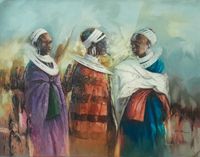

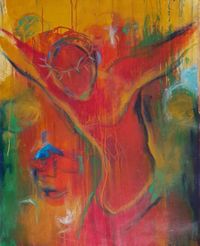


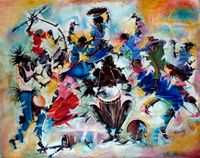




.jpg/picture-200?_=18cdf358988)
